ESTE ARTIGO CONTÉM SPOILERS
THIS ARTICLE HAS SPOILERS
Os créditos surgem acompanhados por uma música
sinistra de parque de diversões. A tela está quase preta, mas podemos sentir
que estamos nos movendo pelas árvores que passam – seríamos nós passageiros em
uma carruagem fantasma? Não, nós estamos apenas no carro de uma mulher que
carrega um cadáver no banco de trás. Do cadáver, ela quer apenas o rosto. O
filme começou há cinco minutos e já sentimos vários arrepios na espinha.
The credits roll accompanied by a sinister merry-go-round
music. The screen is nearly black, but we can sense we’re moving by the trees
passing by us – maybe we’re passengers in a phantom carriage? No, we’re riding
along a woman who carries a lifeless body in her car. From the body, she wants
just the face. We’re five minutes into the film and already have chills down
our spines.
Agora vemos um cientista dando uma palestra sobre
como evitar a rejeição em transplantes de órgãos. Assim como na palestra que
abre “O Médico e o Monstro”, de 1931, um cientista fala abertamente na frente
de um grupo de pessoas sobre os próximos passos de sua perigosa próxima
experiência.
Now we have a scientist giving a lecture about how
to avoid rejection in organ transplantations. Just like in the opening lecture
from 1931’s “Dr Jekyll and Mr Hide”, a scientist discusses in front a group of
people the steps of his next dangerous experiment.
O cientista é o Dr Génessier (Pierre Brasseur), cuja
filha desapareceu recentemente. Ela foi vítima de um acidente de carro e ficou
com o rosto desfigurado. Ela fugiu da clínica onde recebia tratamento. Só que
nada disso aconteceu – o pai a tirou da clínica e começou a fazer experiências
com transplantes faciais nela.
The scientist is Dr Génessier (Pierre Brasseur), whose
daughter disappeared recently. She was a victim in a car crash and her face was
left disfigured. She ran away from the clinic where she was been treated.
Except she didn’t – her father took her away and started experimenting with
facial transplantation surgery on her.
A filha, Christiane (Edith Scob) não está nada
feliz. Ela vive trancada em uma luxuosa mansão, e precisa usar uma máscara para
cobrir suas feridas. Ela passa por diversas cirurgias perigosas e complexas,
mas seu corpo rejeita os novos rostos. E de onde vêm os rostos? Bem, de jovens
mulheres raptadas e mortas pelo Dr Génessier e sua assistente Louise (Alida
Valli), que, aliás, era a mulher dirigindo o carro na primeira cena. Louise
oferece um quarto para uma moça alugar e lá vai – começa o corte.
The daughter, Christiane (Edith Scob) is not happy
at all. She lives locked in a lavish mansion, wearing an ugly mask to cover her
wounds. She goes through several dangerous and complex surgeries, but her body
keeps rejecting the new faces. And where do the faces come from? Well, from
young women kidnapped and killed by Dr. Génessier and his assistant Louise
(Alida Valli), who, by the way, was the woman driving the car in the opening
scene. Louise offers the girl a room to rent, and there they go – cutting her
mercilessly.
Por falar em corte, preciso dar um alerta de gatilho
em potencial: há uma sequência altamente gráfica envolvendo uma cirurgia no
meio do filme. Primeiro, Christiane tira a máscara e a mais nova vítima, Edna
(Juliette Mayniel) vê o rosto dela sem estar coberto. É uma revelação ao estilo
“Fantasma da Ópera”, com uma imagem desfocada que aos poucos revela um rosto
destruído. Logo após este momento, acontece a cirurgia. É o básico da cirurgia
plástica dos anos 60: o Dr Génessier marca o local com um lápis e ali faz o
corte, de onde sai muito sangue – falso, obviamente. Não há problema em se
sentir enojado e fechar os olhos – ou ficar com as mãos no seu próprio rosto
para ter certeza de que ele ainda está lá, como eu fiz enquanto via.
Since we’re talking about cutting, a trigger warning
must be given: there is a very graphic surgery scene in the middle of the
movie. First, Christiane takes off her mask and the newest victim, Edna
(Juliette Mayniel) sees her face without a mask. It’s a “Phantom of the Opera”-style
revelation, with an unfocused image that slowly reveals a destroyed face. Right
after this moment, the surgery happens. It’s 1960’s plastic surgery 101: Dr
Génessier marks the place with a pencil, then comes the cutting and the fake
blood. It’s OK to be disgusted and to look away – or to keep touching your face
to make sure it’s still there, like I did while watching.
Como poderíamos classificar Génessier enquanto
cientista: bom, maluco ou solitário? De certa maneira ele é bom, porque quer
ver a filha feliz e perfeita novamente. Mas para conseguir isso ele se torna um
cientista maluco e mata mulheres para pegar os rostos delas e transplantar em
Christiane. Mas acima de tudo, eu acredito que ele é solitário. Ele perdeu a
esposa quatro anos antes do acidente com Christiane, e agora a filha é tudo
para ele. Ele se sente responsável pelo acidente e quer consertar as coisas –
mesmo que para isso ele deixe um rastro de sangue e destrua muitas outras
vidas. Dito isso, podemos sentir a solidão e o vazio de sua alma em seu rosto
sem expressão – porque mesmo sem um rosto, Christiane é mais expressiva que o
pai, e usa apenas os olhos para isso.
How would we classify Génessier as a scientist:
good, mad or lonely? In a sense he is good, because he wants to see his
daughter happy and perfect again. But in order to do this he goes mad and kills
women to get their faces to transplant in Christiane. But above all, I believe
he is lonely. He lost his wife four years before Christiane’s accident, and now
the girl is everything to him. He feels responsible for the accident and wants
to fix things – even if this leaves blood everywhere and destroys many other
lives. That being said, we can feel the loneliness and the emptiness of his
soul by his face without an expression – yes, because even without her face, Christiane
is more expressive with her eyes than his father with his full face.
Todos os atores no filme estão muito bem. Esta foi a
primeira vez que eu vi Pierre Brasseur em um filme, mas ele esteve em outras
produções famosas que eu ainda pretendo ver. Alida Valli é linda e assustadora,
e Edith Scob – que trabalha no cinema até hoje – é simplesmente maravilhosa. O
diretor Georges Franju foi muito feliz na escolha da trilha sonora – ou na
escolha de não ter trilha sonora em algumas sequências, como na da cirurgia. Ao
contrário da cena do chuveiro de “Psicose”, nós não podemos imaginar esta cena
acompanhada de nenhuma música – o que simplesmente arruinaria o clima de
tensão.
Everybody in this movie is extremely good. This was
the first time I saw Pierre Brasseur in a movie, but he made many other famous
films I have yet to see. Alida Valli is gorgeous and scary, and Edith Scob –
who is still making movies nowadays – is simply wonderful. Director Georges
Franju is very successful in the choice of the music – or the choice of not
having music in some sequences, like the surgery. Unlike “Psycho”’s shower
scene, we can’t imagine this scene accompanied by any song – it’d simply ruin
the tense effect.
“Os Olhos sem Rosto” foi, assim como muitos filmes
revolucionários, mal recebido pelo público e pelos ditos “críticos”. A cena da
cirurgia foi censurada em diversos mercados estrangeiros, e causou frisson nos
países em que foi exibida sem cortes. Como filme de terror, “Os Olhos sem Rosto”
é um os melhores do gênero. Mas como o próprio Franju considerava que este era
um filme sobre angústia, devemos dizer: “Os Olhos sem Rosto” é o melhor filme
sobre angústia já feito.
“Eyes Without a Face” was, like many groundbreaking
films, received badly by the public and the so-called “critics”. The surgery
scene was often censored in foreign markets, and caused frisson wherever it was
fully exhibited. As a horror movie, “Eyes Without a Face” is one of the best of
the genre. But since Franju himself considered it an anguish movie, we must
say: “Eyes Without a Face” is the best anguish movie ever made.
This is my contribution to the Movie Scientist blogathon,
hosted by Christina at Christina Wehner and Ruth at Silver Screenings.

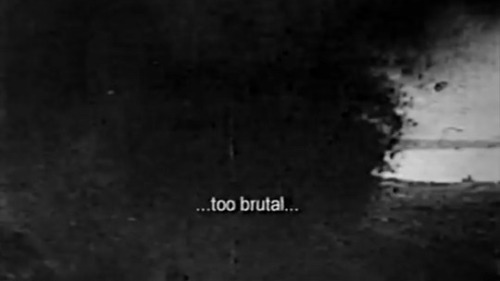
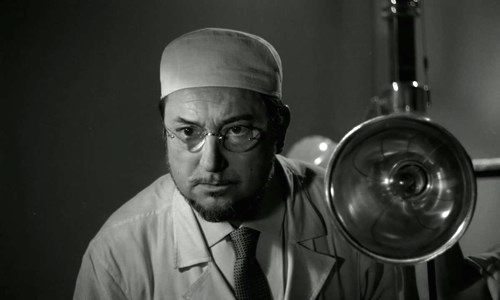

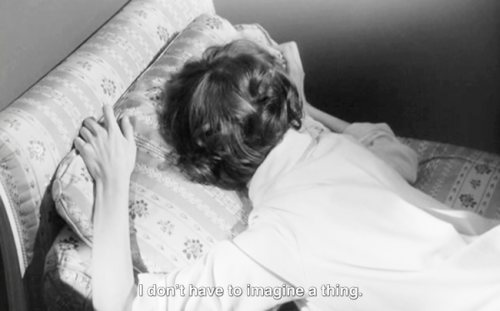
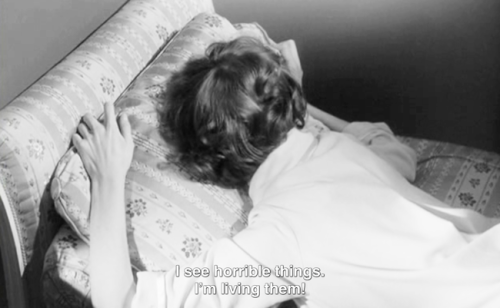
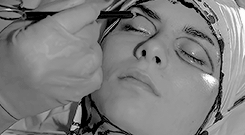


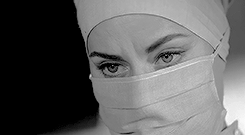

6 comments:
You wrote a moving and emotional piece on this classic horror film. I could definitely feel that anguish.
I had to laugh when you said you kept touching your face while watching this film. I would probably do the same thing!
This film sounds horrifying and sad and VERY thought-provoking, all at the same time. How far would we go to help a person we cherish?
Thanks for joining the blogathon, and for sharing this thoughtful essay with us.
Yikes, I wanted to touch my face while reading about the surgery! This sounds very chilling and tragic at the same time. And your screen shots of the daughter wearing the mask are haunting.
I had been considering watching this, but didn't know too much about it. I definitely want to see it now; though, like you, I might look away during the surgery. :)
Thanks for such a lovely review of this film and for joining the blogathon!
Just reading about it gives me the chills!
I love this movie! She's so ghostly and creepy through so much of it, and the gruesomeness Franju got away with is impressive for its time.
Thank you for writing about this film! I'm scared to see it, but I'm eager to watch it now after reading your thoughts about it.
Post a Comment